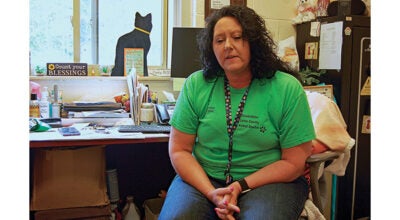CDC offers considerations as Christmas quickly approaches
Published 8:37 pm Thursday, December 17, 2020
|
Getting your Trinity Audio player ready...
|
BY IVAN SANDERS
STAR STAFF
ivan.sanders@elizabethton.com
Heading into one of the most looked-forward-to holidays on the calendar, it is evident that Christmas 2020 will be unlike any Christmas that many will have ever experienced in their lifetime.
Being identified as one of the fastest-growing areas in the country for positive cases of COVID-19, the holiday will bring a time of decision for families who have long used the day to gather together to open gifts, share in either meals or finger foods, and enjoy the time of fellowship.
In Ballad Health’s scorecard released on Thursday, December 18th, the positivity rate has dropped only .4 of a point to 23.8 percent which still means that roughly one out of every four people tested will have a positive test result.
Currently, 320 people are hospitalized and there have been 94 deaths in the last seven days in the 21-county Ballad Health reporting area.
So, the question remains what to do about Christmas.
The Center for Disease Control released a supplement advising some steps to consider above the already requested mask-wearing, hand washing, and social distancing.
According to the CDC, celebrating virtually or with members of your own household will pose the lowest risk for spread. For clarification, the household is anyone who currently lives and shares common spaces in your home.
These include family members as well as roommates or people who are unrelated to you. It is interesting to note that the CDC says that in-person gatherings that bring family members or friends from different households, including college students returning home, pose varying levels of risk.
The CDC shared the following factors that can contribute to the risk of getting and spreading COVID-19 at small in-person gatherings.
Community levels of COVID-19 – High or increasing levels of COVID-19 cases in the gathering location, as well as in the areas where attendees are coming from, increase the risk of infection and spread among attendees. Family and friends should consider the number of COVID-19 cases in their community and in the community where they plan to celebrate when deciding whether to host or attend a gathering. Information on the number of cases in an area can often be found on the local health department website or on CDC’s COVID Data Tracker County View.
Exposure during travel – Airports, bus stations, train stations, public transport, gas stations, and rest stops are all places travelers can be exposed to the virus in the air and on surfaces.
Location of the gathering – Indoor gatherings, especially those with poor ventilation (for example, small enclosed spaces with no outside air), pose more risk than outdoor gatherings.
Duration of the gathering – Gatherings that last longer pose more risk than shorter gatherings. Being within 6 feet of someone who has COVID-19 for a cumulative total of 15 minutes or more greatly increases the risk of becoming sick and requires quarantine.
Number and crowding of people at the gathering – Gatherings with more people pose more risk than gatherings with fewer people. CDC does not have a limit or recommend a specific number of attendees for gatherings. The size of a holiday gathering should be determined based on the ability of attendees from different households to stay 6 feet (2 arm lengths) apart, wear masks, wash hands, and follow state, local, territorial, or tribal health and safety laws, rules, and regulations.
Behaviors of attendees prior to the gathering – Individuals who did not consistently adhere to social distancing (staying at least 6 feet apart), mask-wearing, handwashing, and other prevention behaviors pose more risk than those who consistently practiced these safety measures.
Behaviors of attendees during the gathering – Gatherings with more safety measures in place, such as mask wearing, social distancing, and handwashing, pose less risk than gatherings where fewer or no preventive measures are being implemented. Use of alcohol or drugs may alter judgment and make it more difficult to practice COVID-19 safety measures.
For those who elect to host gatherings, the CDC also released a set of guidelines to consider when hosting a Christmas get together for people who come from different households.
The hosts need to consider the following:
Check the COVID-19 infection rates in areas where attendees live on state, local, territorial, or tribal health department websites or on CDC’s COVID Data Tracker County View. Based on the current status of the pandemic, consider if it is safe to hold or attend the gathering on the proposed date.
Limit the number of attendees as much as possible to allow people from different households to remain at least 6 feet apart at all times. Guests should avoid direct contact, including handshakes and hugs, with others not from their household.
Host outdoor rather than indoor gatherings as much as possible. Even outdoors, require guests to wear masks when not eating or drinking.
Avoid holding gatherings in crowded, poorly ventilated spaces with persons who are not in your household.
Increase ventilation by opening windows and doors to the extent that is safe and feasible based on the weather, or by placing central air and heating on continuous circulation. If setting up outdoor seating under a pop-up open-air tent, ensure guests are still seated with physical distancing in mind. Enclosed 4-wall tents will have less air circulation than open-air tents. If outdoor temperature or weather forces you to put up the tent sidewalls, consider leaving one or more sides open or rolling up the bottom 12 inches of each sidewall to enhance ventilation while still providing a windbreak.
Require guests to wear masks. At gatherings that include persons of different households, everyone should always wear a mask that covers both the mouth and nose, except when eating or drinking. It is also important to stay at least 6 feet away from people who are not in your household at all times.
Encourage guests to avoid singing or shouting, especially indoors. Keep music levels down so people don’t have to shout or speak loudly to be heard.
Encourage attendees to wash their hands often with soap and water for at least 20 seconds. If soap and water are not readily available, use a hand sanitizer that contains at least 60% alcohol.
Provide guests information about any COVID-19 safety guidelines and steps that will be in place at the gathering to prevent the spread of the virus.
Provide and/or encourage attendees to bring supplies to help everyone to stay healthy. These include extra masks (do not share or swap with others), hand sanitizer that contains at least 60% alcohol, and tissues. Stock bathrooms with enough hand soap and single-use towels.
Limit contact with commonly touched surfaces or shared items, such as serving utensils.
Clean and disinfect commonly touched surfaces and any shared items between use when feasible. Use the EPA-approved disinfectantsexternal icon.
Use touchless garbage cans if available. Use gloves when removing garbage bags or handling and disposing of trash. Wash hands after removing gloves.
Plan ahead and ask guests to avoid contact with people outside of their households for 14 days before the gathering.
Treat pets as you would other human family members – do not let pets interact with people outside the household.
By following as many of these supplement recommendations provided by the CDC, the safer the gatherings will be.






